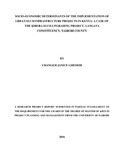| dc.description.abstract | The proliferation of huge slums in Kenya has become evident as the rate of urbanization increases, has increased in most of the slum dwellers and they live in degrading conditions. The Kibera Slum Upgrading Project was attempted by the Government of Kenya and different accomplices through the Kenya Slum Upgrading Program (KENSUP) and Kenya Informal Settlement Improvement Program (KISIP) went for giving better lodging and upgraded job to the general population as they were confronted with issues like poor water and sanitation, security of land tenure and vulnerability to evictions, low income generating activities, high rate of unemployment and ever-increasing level of marginalization of poor neighborhoods. Despite the progress made on slum improvement, this has not been enough to counter the growth of the slums as the absolute number of slums residents/problem have continuously increased despite the upgrading efforts. It is in this context, that this study seeks to establish the socio-economic determinants of the implementation of urban slum infrastructure projects in Kibera. The present study seeks to understand whether projects carried out in these areas are successful or not in terms of land tenure, community participation, profitability of slum business and economic status, based on the residents’ satisfaction with the various socio-economic determinants. This study described experiences of 293 respondents with respect to their level of understanding on various issues influencing the implementation of slum upgrading project using a validated questionnaire. Data was analysed using the Statistical Package for Social Sciences (SPSS) version 20.0. Descriptive statistics and binary logistic regression were used to analyse the data and results presented in terms of frequencies and percentages. A correlation analysis was also conducted on the data to determine the extent of their relationship to implementation of slum upgrading projects. The study revealed that 85.1% and 73.1% of the respondents in Katwekera and Mashimoni wards, respectively, were extremely dissatisfied with the housing conditions. Despite the level of dissatisfaction, 96.6% and 91.7% of respondents in Katwekera and Mashimoni wards, respectively, were not willing to be relocated to improved housing with higher rents. In the two villages, all the respondents have never owned land or neither do they have a land title. Cumulatively, 73.6% and 62.1% of the respondents in Katwekera and Mashimoni wards, respectively, were extremely dissatisfied with land ownership issues. In Katwekera ward, 76.4% of the residents have never participated in any slum upgrading project, while in Mashimoni ward, 58.6% reported the same. The findings also revealed that 74.3% and 80.7% of the respondents in Katwekera and Mashimoni wards, respectively, were not willing to abandon their businesses to participate in slum upgrading projects. However, there was a positive correlation between income and satisfaction of slum upgrading project outcome. The findings demonstrated that slum upgrading activities in the two villages are still at their early phases of implementation with very little impact. The study recommends that the government and other partners should address the issue of land tenure, community involvement, profitability of slum business as well as economic status of the slum dwellers which are the major drivers fuelling resistance to the implementation of upgrading programs in the slums as this will improve on community satisfaction. | en_US |



